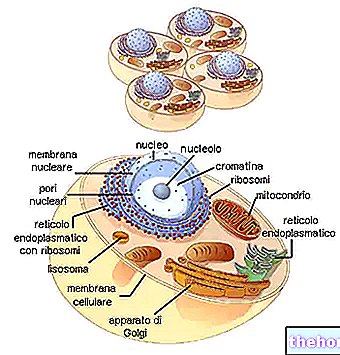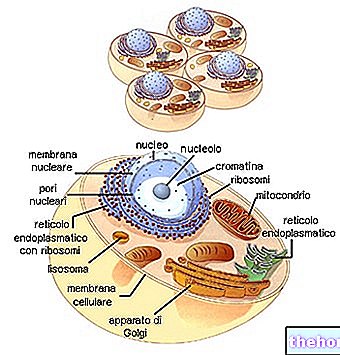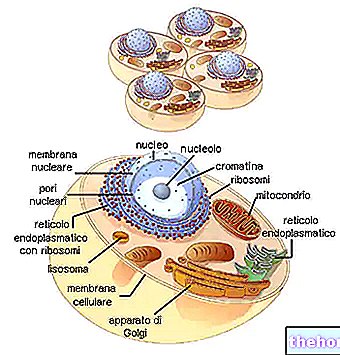The cyclical continuity of living beings finds the links between successive generations in the phenomena of reproduction.
Reproduction is carried out at different levels of the evolutionary scale, in the different ramifications of the vegetable and animal kingdoms, in the different living species, with such a variety of mechanisms that alone justifies an entire treatise.
A first classification of the phenomena of reproduction must distinguish unicellular from multicellular organisms, since only in the former does cell division coincide with reproduction.
In multicellular, reproduction can be agamic or sexual (or gamic).
Agamic reproduction, relatively less frequent, is based on the mechanism of mitosis, so that the variability of the species is rather entrusted to the repeated occurrence of mutations.
There are also different mechanisms, such as strobilization, sporulation, etc., while in plants we find regenerative forms well known in agriculture (cuttings, layering, etc.).
The most widespread reproductive mechanism in the higher forms, however, is the sexual one, corresponding to the appearance of meiosis, the formation of gametes and their fusion in the zygote (fertilization).
In primitive species the gametes are not morphologically differentiated: in this case we speak of isogametia. However, there are always two series of gametes, identified with the symbols (+) and (-) and fertilization can only take place from the "encounter between gametes of opposite sign: there is therefore a biological difference, not yet expressed morphologically.
As the evolutionary scale proceeds, morphological and functional differentiation appears, in which a type of female gametes generally endowed with abundant reserve material (the deutoplasm or calf, which will ensure the development of the embryo until it can be metabolically independent ) and a type of male gametes endowed with motility to reach female ones. Gametes are always haploid and are the result of meiosis. Their fusion gives rise to the diploid zygote.
Between meíosis and zygote a series of haploid cell generations can elapse, just as between zygote and meiosis a series of diploid cell generations can elapse, with the different varieties of generative cycles expressed by the alternation of generations.
A diplonte species (with a diploid organism) is characterized by gametic meiosis: meiosis directly produces the gametes, which by merging immediately reconstitute the diploid state. This is the prevalent case of the Metazoans, including man.
Gametogenesis
Taking into consideration the reproduction with gametic meiosis, as it occurs in man, let's try to clarify how meiosis fits into gametogenesis (formation of gametes).
In embryonic development, of male and female gametogenesis (called spermatogenesis and oogenesis), there is an early differentiation between the cells destined to form the body (somatic line) and those destined to produce gametes (germ line). The initial cells of the germ line are called protogons. With the differentiation of the gonad in the male or female sense there is the differentiation of the germ cells respectively into spermatogonia and ovogonia.
Looking at spermatogenesis, we see that there is a series of cell generations in the spermatogonia, which continues throughout life. Only a part of the spermatogonia thus continuously produced differs from the normal mitotic cycle and the meiotic one begins instead.
The germ cell in which meiosis will begin (reduplication and then first division) is called first order spermatocyte; its division gives rise to two second-order spermatocytes, which with the second division give rise to a total of four spermatids.
We can graduate the reduction of the chromosomal kit from 4n of the first order spermatocytes (after reduplication there are four chromatiles for each pair of homologs) to the 2n of the second order spermatocytes and to the n of the spermatids, as already seen by studying meiosis, which Thus we conclude. The spermatids are therefore already haploid, but they are not yet mature gametes. From the structure of a haploid type cell, functional maturation (called spermiohistogenesis) transforms the spermatids into spermatozoa, that is, mature male gametes.
In female gametogenesis (or oogenesis) there are several differences. First of all, the number of gametes to be prepared is much smaller. It is estimated that about 5 X 105 ovogones are prepared in the gonads of a female of the human species; of these, only about 400 are interested in follicle maturation and subsequent dejection, in a cycle that usually affects only one follicle per month for a fertile period of about 35 years.
The different number of gametes prepared in the two sexes corresponds to the difference in function and behavior already mentioned: the spermatozoa are small, mobile and numerous in relation to the need to search for the egg and the low probability of finding it; the eggs are large, inert and few, in relation to the function of guaranteeing the embryo the reserve material and the protection provided to them by internal fertilization (naturally, especially in external fertilization the ova must also be more numerous).
The need to provide gametes with reserve material corresponds to the presence, in the "oogenesis, of a phase of arrest of meiosis, during which the chromosomes are partially despiralized. We then observe the so-called" feather chromosomes ", in which a series of extroversions identifies the traits in which the genes responsible for the synthesis of deutoplasm are derepressed.
The smaller number required for female gametes also corresponds to the fact that, of the four haploid cells produced by meiosis, only one receives the entire reserve material and becomes a gamete, while the other three (the polocytes or polar bodies), which contain only chromosomal material, cannot give rise to zygotes and embryos and are destined to regress.
Fertilization
Fertilization, that is, the encounter between the male and female gamete, can be carried out in very different ways.In the animal kingdom we observe the transition from external fertilization (gametes exposed to any environmental risk and therefore necessarily very numerous in the two sexes) to internal fertilization, to which parental care is further linked up to the metabolic relationship of mammals between mother and fetus.
Fertilization, once the encounter between gametes of the opposite sex has taken place, must take place guaranteeing two conditions: specificity and uniqueness. That is, it must be ensured that the spermatozoon is of the same species as the egg and that, once the first one enters, no others enter.
Specificity is ensured by the biochemical characteristics of the acrosome and the surface of the ovum. In fact, there is talk of reactions between «fertilisins» and «antifertilisins», with specificity comparable to that of the encounter between enzymes and substrate.
The uniqueness of fertilization is guaranteed by a modification of the surface structure of the ovum («cortical reaction») which begins at the moment of the first specific fertilisin / antifertilisin reaction; after this reaction the membrane of the ovum is altered, so that any other spermatozoa that reach it are no longer able to initiate the specific fertilization reaction.
Following fertilization, the tail of the spermotozoan remains external to the ovum, while the chromosomal material penetrates it. This, called the "male pronucleus", joins the "female pronucleus" of the ovum thus forming the diploid nucleus of the zygote.









.jpg)


















